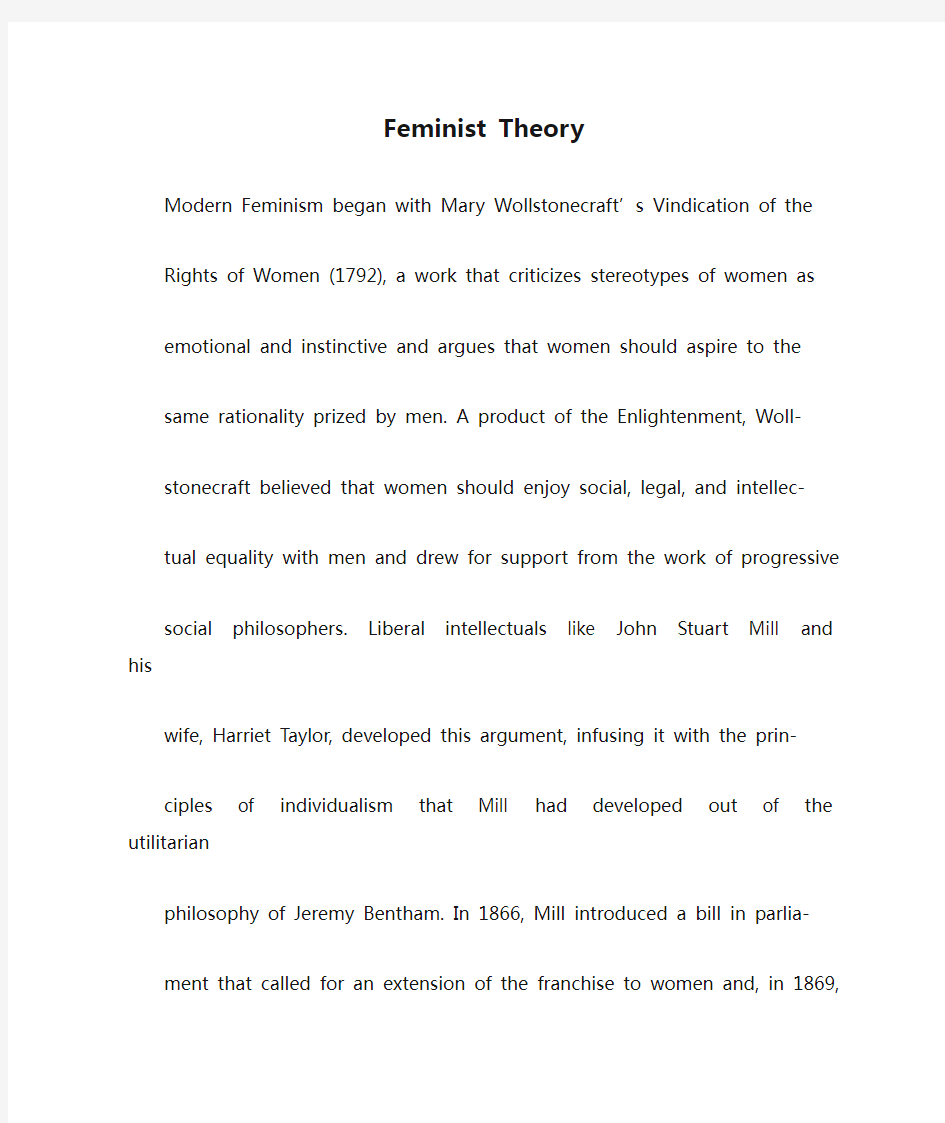文艺理论:女性主义(Feminist Theory)原版阅读

- 1、下载文档前请自行甄别文档内容的完整性,平台不提供额外的编辑、内容补充、找答案等附加服务。
- 2、"仅部分预览"的文档,不可在线预览部分如存在完整性等问题,可反馈申请退款(可完整预览的文档不适用该条件!)。
- 3、如文档侵犯您的权益,请联系客服反馈,我们会尽快为您处理(人工客服工作时间:9:00-18:30)。
Feminist Theory
Modern Feminism began with Mary Wollstonecraft‟s Vindication of the
Rights of Women (1792), a work that criticizes stereotypes of women as
emotional and instinctive and argues that women should aspire to the
same rationality prized by men. A product of the Enlightenment, Woll-
stonecraft believed that women should enjoy social, legal, and intellec-
tual equality with men and drew for support from the work of progressive
social philosophers. Liberal intellectuals like John Stuart Mill and his wife, Harriet Taylor, developed this argument, infusing it with the prin-
ciples of individualism that Mill had developed out of the utilitarian
philosophy of Jeremy Bentham. In 1866, Mill introduced a bill in parlia-
ment that called for an extension of the franchise to women and, in 1869,
published The Subjection of Women (1869). In that essay he argued that
women ought to enjoy equality in the social sphere, especially in mar-
riage, and condemned “forced repression” and “unnatural stimulation”
(276): “All women are brought up from the very earliest years in the
belief that their ideal of character is the very opposite to that of men;
not self-will, and government by self-control, but submission, and yield-
ing to the control of others” (271). Mill‟s views, infl uenced strongly by
Taylor, marked a signif icant advance for women and provided the inspi-
ration for the New Woman movement at the end of the nineteenth- and
the early-twentieth-century suffragette movements committed to social
equality and individual freedom.
The fi rst phase or “wave” of modern Feminism, then, was concerned
primarily with the issue of suffrage (the right to vote). The dominant
fi gures at mid-nineteenth century in the US were Elizabeth Cady Stanton
and Susan B. Anthony, whose political roots were in anti-slavery activ-
ism and, to a lesser degree, temperance movements. Stanton composed
the “Declaration of Sentiments” for the Seneca Falls women‟s rights convention in 1848, a watershed moment in US Feminism. Modeled on
the US Constitution, the Declaration asserts “that all men and women
are created equal,” and indicts a patriarchal culture for repressing the
rights of women: “T he history of mankind is a history of repeated inju-
ries and usurpations on the part of man toward woman, having in direct
object the establishment of an absolute tyranny over her” (Sourcebook).
Together with Matilda Joslyn Gage, Stanton wrote the “Decl aration of
95
Rights of the Women of the United States” for the Centennial celebration
